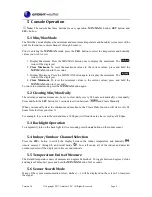
Version 1.0
©Copyright 2017, Ambient LLC. All Rights Reserved.
Page 11
5.8.2
Temperature Calibration
Prior to entering the calibration mode, press the
CH/+
button to select the temperature you wish to
adjust.
To enter the temperature calibration mode, press and hold the
SET and CH/+
button for 5 seconds
and the temperature value will begin flashing. Press the
CH/+
button to increase the temperature and
the
MIN/MAX/-
button to decrease the temperature reading in 0.1° increments. To rapidly increase
(or decrease) the temperature reading, press and hold the
CH/+
or
MIN/MAX/-
button.
To return the temperature to the actual or uncalibrated measurement, press the
SET
button.
will be displayed when the temperature calibrated measurement.
Once the displayed temperature equals the calibrated source, press and hold the
SET
button for three
seconds, or wait 15 seconds for timeout, and the temperature value will stop flashing.
Discussion
:
Temperature errors can occur when a sensor is placed too close to a heat source (such
as a building structure, the ground or trees).
To calibrate temperature, we recommend a mercury or red spirit (fluid) thermometer. Bi-metal (dial)
and other digital thermometers are not a good source and have their own margin of error. Using a local
weather station in your area is also a poor source due to changes in location, timing (airport weather
stations are only updated once per hour) and possible calibration errors (many official weather stations
are not properly installed and calibrated).
Place the sensor in a shaded, controlled environment next to the fluid thermometer, and allow the
sensor to stabilize for 48 hours. Compare this temperature to the fluid thermometer and adjust the
console to match the fluid thermometer.
6
Glossary of Terms
Term
Definition
Accuracy
Accuracy is defined as the ability of a measurement to match the actual
value of the quantity being measured.
Hygrometer
A hygrometer is a device that measures relative humidity. Relative
humidity is a term used to describe the amount or percentage of water
vapor that exists in air.
Range
Range is defined as the amount or extent a value can be measured.
7
Specifications
7.1 Wireless Specifications
Line of sight wireless transmission (in open air): 300 feet, 100 feet under most conditions.
Frequency: 433 MHz
Update Rate: 60 seconds


































